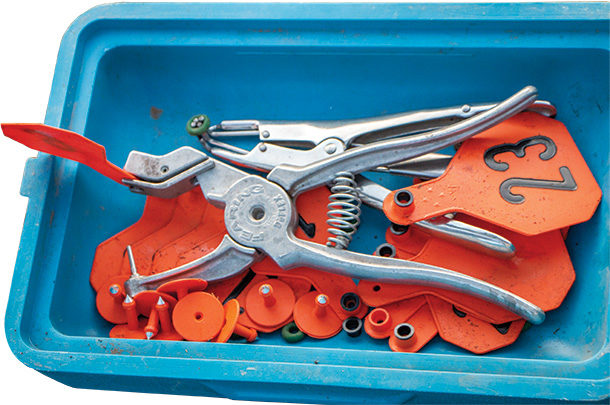Individual animal identification allows livestock producers to maintain profit-generating records, such as production and breeding, health and treatment history, weight and more for every head of livestock on their operation.
David Bell, a cattleman in Troup, Texas, has benefited from animal ID and recordkeeping by facilitating earlier culling and improved breeding decisions for his Brangus herd. “For my cows, I knew when they were bred based on their tag numbers because I’ve kept records on [them],” Bell says. “Also, with their tag numbers, you can record how their calves perform every year.” Weaning weights are an important factor for earlier culling, “if her calves were consistently not keeping up with the weight of the others.”
Bell also comments on how recordkeeping helps cattlemen select the best-performing bulls. “You can manage your cow herd, as well as identify what kind of calves the bull is producing,” Bell says. “When you have four or five bulls siring calves, it helps you to know which bull is producing the best calves and which set of cows that bull would work better with.”
With animal ID, producers are able to confidently keep back their best-performing cattle.
“Animal identification and herd recordkeeping continue to evolve for improved time management and efficiency,” says Arnold Nagely, DVM and co-founder of Valley Vet Supply. “Traditional herd identification methods, such as visual ID tags and entries made by producers into handwritten pocket notebooks, are now being incorporated into electronic identification [EID], also referred to as radio frequency identification [RFID] eartags, for seamless transition into cattle management software.”
While most producers use visual ID tags, EID tag use continues to increase for a number of reasons, including:
- EID enhances traceability and management. No two animals share the same tag number, allowing that animal to be traced from birth to harvest. Tag manufacturers provide instant download to a producer’s computer of each tag ID number shipped to them, offering a quick listing of their tag numbers and becoming the baseline for recordkeeping. From here, cattlemen can add existing herd records, including visual ID number, tattoo number, health records, breeding performance and more.
- EID saves time. EID tags can be scanned and information updated at chute side using a stick reader or through weigh scale indicators, automatically syncing data to their EID data program on their computer or mobile application. EID tags are available in high-performance half duplex (HDX) or full duplex (FDX) technology. HDX tags offer the greatest read distance and readability through interference. HDX technology is ideal for permanent weigh systems at packing plants using automated reading systems or walk-through readers. If you have a portable weigh system and closer readability is accessible for your management program, FDX tags are a cost-efficient solution, in which data can be captured by using an EID stick reader or wand at the chute or in an alleyway.
- Some packers even require EID. It isn’t uncommon for packing plants to require EID tags to tie back carcass data, marbling and more in an automated manner.
- EID improves accuracy. When producers are manually entering data into a spreadsheet, or penning herd health information into a calf book, this naturally leaves room for human error.
“I have never lost a computer, but I have lost a lot of calf books,” says Scott Holt, Idaho rancher and Allflex North America marketing manager.
Holt runs Hereford and Angus cattle on his Idaho ranch. And with his background at Allflex, which identified some 500 million animals last year alone – we tagged him in for Q&As relating to all things cattle eartags.
Q: When is the best time to apply eartags?
Everything starts with a tag. Apply them as early as possible. It is common for the visual ID tag to be applied at birth and the EID tag applied at branding, but applying both visual and EID tags at birth is the best approach.
Q: What’s the benefit of applying both at birth?
The advantage is that newborn calves will experience less stress at that young age. They also have clean ears, so producers will see fewer infection issues than with older cattle with dirt and grime in their ears. We always recommend putting the visual and EID tag on them at birth, as it’s the best option from an animal care standpoint.
Q: What tips do you have for applying eartags?
First – make sure eartags are clean and not laying in the back of a dusty truck. Disinfect the buttons of tags; this helps provide lubrication and cleanliness through the ear. For traditional visual tags, place in the dead center of the ears between the two main ribs. Face ear straight on, put the button on the backside of the ear and the visual tag on the front. For EID tags, to fully clear the visual tag, we recommend putting them toward the inside of the ear, closer to the head. Do not apply to the top of the ear.
Q: How do you recommend producers select size and color of eartags?
That’s an easy answer but also a tough answer. It depends on their operation. White, yellow and orange tags are most popular, as are the cow-size tags [also known as the maxi size]. At the end of the day, the bigger the tag, the poorer the retention. Producers will need to balance out how big they want the printing and how much they want to improve retention.
Q: What are benefits to incorporating animal ID?
We can only measure what we have recorded. Without recordkeeping, we can’t improve the genetics and health of our herd. It all starts with a tag, and any information producers want to record about an animal can be recorded to that unique herd number: birthweight, sire, dam, administered treatments and vaccinations. And on the feedyard side, they want to know the animal’s average daily gain (ADG) and then at harvest time, marbling and yield grade level. These are all easiest to record electronically with an EID tag.
Q: How is animal ID upping profits for producers?
If you look at the video sale piece, folks are using third-party programs to achieve the biggest premiums today. AngusLink 2020 video sale data reported an average premium of $9.93 per hundredweight. It’s just the real world of running a ranch; I don’t feel you can do a good job managing animals without ID because you just don’t know. You might not know that this cow has produced the highest weaning weights if you don’t record those things.
Q: When might a producer use blank tags over numbered tags?
Blank tags are good if you don’t have a pre-planned numbering system, or if you want to use multiple colors with the same numbering sequence. Pre-numbered tags have better longevity due to laser ink technology. There is actually a metal additive used, with ink over the top of it, for a more permanent mark. A blank tag marked with a pen is better than nothing, but a permanent mark from the factory is best from a longevity and visibility standpoint.
Q: Mind talking about how cattle health and tags go hand in hand?
Animal ID is a big tool to better animal health. For this reason, Merck actually acquired Allflex more than a year ago to tie animal health into the big picture. Everything starts with a tag – from proper dosage to recordkeeping. You can even take it a step further for genomic improvements by doing a tissue sampling unit on those cattle, or investing in a monitoring tool that can pinpoint so much; you can even know your heifer is in heat and to be at the corral at 6 p.m. for breeding.









